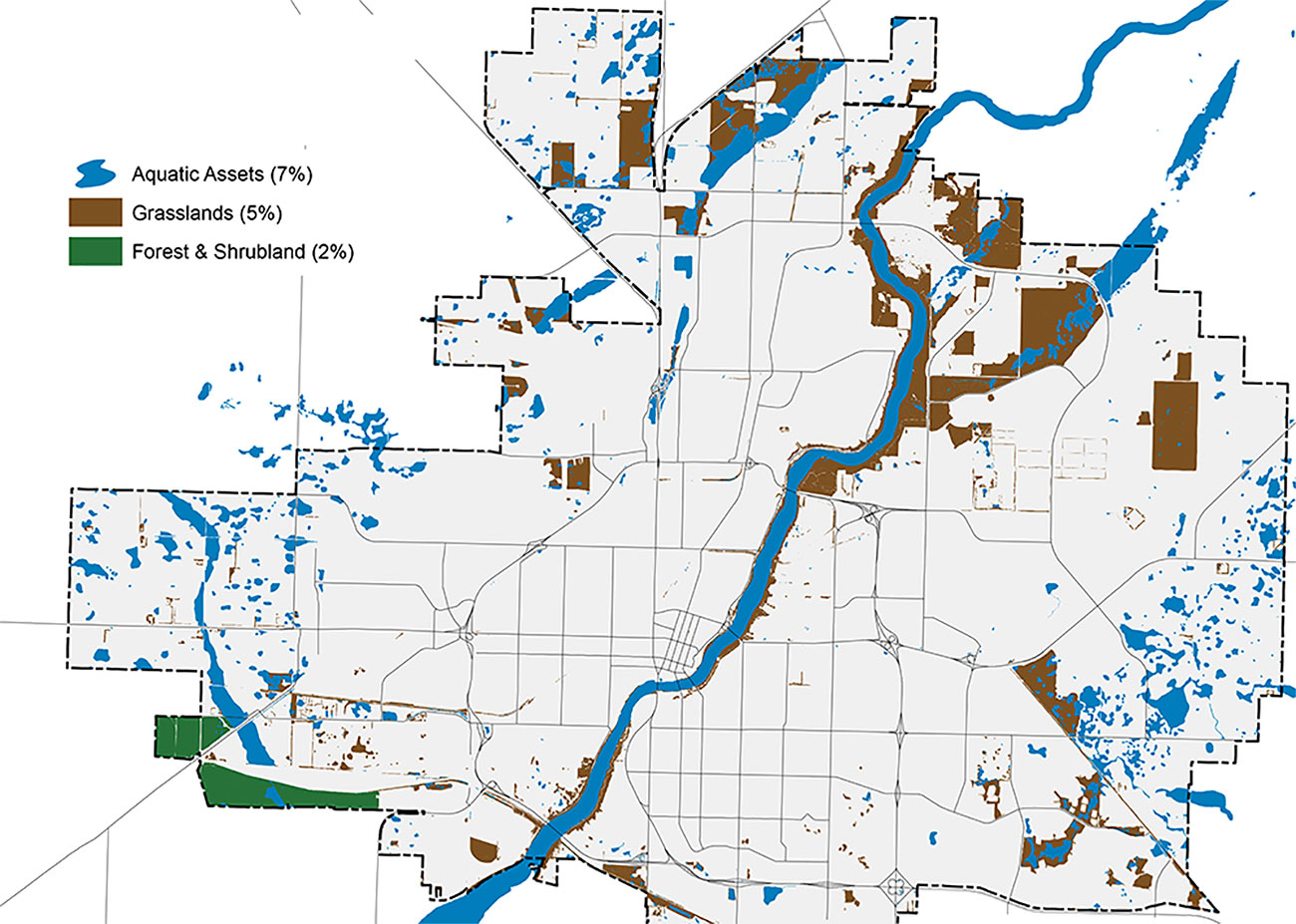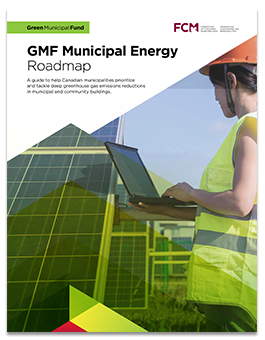To inform planning for future urban development and climate change adaptation, the City of Saskatoon completed a pilot project to assign measurable value to its natural assets. The Natural Capital Asset Valuation pilot project generated an inventory of local natural assets, identified the specific ecosystem services they provide and assigned financial value to those services. The project, which received funding from the Municipalities for Climate Innovation Program (MCIP), provided valuable information for the management of Saskatoon’s natural assets.
Read this case study to understand how assigning measurable value to natural assets can inform municipal strategies for asset management and climate change.
Key success factors
- The project raised awareness and increased appreciation of the ecosystem services provided by natural assets.
- The evolution of the project was an example of successful adaptive management: with the departure of a key staff member and other challenges to achieving the original project scope, the team refocused the project to a more manageable scope.
- Getting started on a new aspect of asset management, even when a municipality is not ready to complete an ambitious set of goals, can yield tangible progress, generate valuable knowledge and lay the groundwork for next steps.
What was the aim of the project?
A municipality’s green infrastructure—the water, soil, plants and animals that provide various services to residents—is largely made up of its natural assets, or natural capital. Within Saskatoon’s city limits are more than 1,400 wetlands, a portion of the South Saskatchewan River, grasslands and forest or shrublands. These natural assets provide important services to the community but have not traditionally been recognized for their value. As a result, they may not be included in municipal strategies for asset management or managing climate change risks.
The City of Saskatoon needed a way to assign measurable value to its natural assets, enabling planning for future development and for climate change impacts. The city tackled the Natural Capital Asset Valuation pilot project to evaluate the ecosystem services provided by the city’s natural assets and measure their financial value. Through the pilot project, the city set out to develop an accounting and reporting framework, create an inventory of natural assets, assess their vulnerability and complete a valuation.
What steps were involved in the project?
The pilot project had three phases, completed by municipal staff with assistance and input from internal and external subject matter experts. While the municipality had originally intended to use accounting metrics—such as life cycle costing, maintenance costs and replacement costs—to value natural assets, the plan changed due to the departure of the team member with the expertise to establish those metrics. Staff realized that the accounting framework originally proposed, whose application would have been a first in Canada, was too ambitious. The project was reframed, moving from a detailed accounting framework to a simplified one focusing on ecosystem services.
In the first phase, the city worked with the Meewasin Valley Authority, a non-profit organization, to compile an inventory of natural assets. The project dealt only with natural assets larger than 2.5 ha in size and located within the city limits to keep the project scope manageable and to leverage key existing partnerships within that area. The city chose two natural assets for the initial detailed valuation portion of the project: the Small Swale, a glacial channel scar that connects to the South Saskatchewan River and includes a native grassland and wetland, and the Richard St. Barbe Baker Afforestation Area, which consists of wetlands, native grasslands and forest. The two assets included a representative mix of habitat types, have been studied previously and have been discussed often in council in relation to ecosystem vulnerabilities and nearby development.
The second phase involved identifying the specific ecosystem services that would be used for the valuation of the two chosen natural assets. To do this, the city drew guidance from a number of sources, including the framework set out by the United Nations in the Millennium Ecosystem Assessment, the Economics of Ecosystems and Biodiversity initiative and discussions with subject matter experts. An advisory committee with internal and external stakeholders helped to identify ecosystem services, collect data and review the final report. In this phase, the city—through an extensive consultation process—also completed a vulnerability assessment to determine the climate change risks facing the natural assets in its inventory.
In the third phase, the city used the value transfer method to assign value to the ecosystem services identified. This involved reviewing literature and consulting with a diverse group of subject matter experts to find values established for similar ecosystems in other studies. The priority was to first use any values already established within Saskatchewan; for example, values from Saskatchewan were obtained for nutrient removal and wetland/grassland carbon sequestration. If unavailable at the provincial level, the team then sought data from Canada (e.g. for cultural services) as well as from a global ecosystem service valuation database (e.g. for the supporting services value for wetlands). The city completed a full valuation of the two natural assets selected for this project and extrapolated the results to the other assets in the inventory, calculating average value per hectare.

What was achieved?
A core benefit of the project was increased awareness and appreciation of ecosystem services as well as greater understanding of the knowledge gaps that must be addressed to properly value and manage Saskatoon’s natural assets.
The work yielded a number of technical and operational findings, such as the amount of carbon dioxide equivalent (CO2e) stored in the soil and biomass of the city’s natural assets, the recreational services provided by key natural assets and the identification of at-risk areas to be prioritized for asset management planning.
The city was able to assess the annual financial value of the ecosystem services generated by the two assets evaluated in the pilot, as well as their habitat value in financial terms. The project also roughly estimated the total annual value of the natural assets in the city’s inventory: $48.2 million per year.
Overall, the project was the first step toward the implementation of a valuation system for the city’s natural assets. The natural asset inventory completed for the project established a baseline for the ongoing identification of significant natural assets within city limits. Although it wasn’t possible to set up a full valuation framework using accounting metrics, the project increased the city’s knowledge and expertise enough to enable a high-level cost-benefit analysis for managing natural assets.
Insight and lessons learned
- There is value in getting started, even when circumstances are not ideal: Although the city did not have all the data or expertise needed, the process of creating the inventory and completing the pilot valuation laid the groundwork for further progress.
- The use that will be made of project outputs should inform the choice of project methodology: In the end, the simpler method the city adopted yielded results that were at the right level of detail for this initial step.
- Lack of federal accounting standards can limit the ability to value natural assets, depending on internal municipal capacity and readiness: Natural assets are not yet a reporting requirement under Public Sector Accounting Board (PSAB) standards. Without PSAB guidance, it can be difficult for Canadian municipalities to establish consistent standards for financially valuing natural assets. This posed a challenge for the City of Saskatoon (where buy-in was not universal across the corporation) and contributed to the decision to use the value transfer method.
- When assigning numerical value to ecosystem services, it’s important to include the caveat that the numbers are not complete: The project team faced information gaps and the challenge of extrapolating values from other studies—and ultimately knew that all the values established were just estimates and that the totals were under-valued.
- Stakeholders and experts should be involved as much as possible from the beginning: Input from internal and external subject matter experts and stakeholders with different views on ecosystem services (including cultural services) helped define and value those services.
- Time constraints and limited data may impact the level of detail that is achievable: The short time frame for completing phases two and three of the project, and the limited data available on some of the services provided by the natural assets, contributed to the city’s decision to transfer values from other studies of similar areas rather than establish its own method for calculating the value of natural assets.
- Staff turnover and departmental silos can impact project scope: The scope of the project had to be altered following the departure of a key staff member. Departmental silos and varying states of readiness also limited the city’s capacity to assemble a multidisciplinary team with the full range of expertise (as well as a centralised data bank) needed to complete the project as planned.
- Learning from other municipalities contributes to success: Knowledge shared by other municipalities, through publications and a webinar hosted by the Municipal Natural Asset Initiative, helped staff define and scope the city’s natural assets.
"You can’t always wait for every piece of information to be in place before you start. The main thing is to get started and keep the ball rolling, while identifying gaps along the way."
– Twyla Yobb, Watershed Protection Manager, City of Saskatoon
Next steps
Incorporating accounting metrics into natural asset valuation is a longer-term goal that is linked to the development of national standards through the Public Sector Accounting Board. Until such a time, the City of Saskatoon is moving ahead with building its knowledge about ecosystem services and taking steps to incorporate the valuation into the management of natural assets.
The city’s Corporate Asset Management Plan (2019) and the Green Infrastructure Strategy (2020) are the main documents through which the team will further its work on natural assets. Under these strategies, city staff will request funding in 2022 to develop management plans for natural assets—although COVID-19 may affect the availability of funding.
The recognition of natural capital is also influencing changes to the land use designation process, and the natural asset inventory will be used to inform future city Sector Plan amendments. The inventory will identify natural assets that the city may wish to conserve and will provide preliminary boundaries for consideration in the planning process.
The city has been working with Meewasin Valley Authority, which maintains the riverbanks of the South Saskatchewan River, to explore how to move forward with management of the natural assets in the inventory.
By the numbers

$125,000
MCIP grant

3461 hectares
size of Saskatoon’s main natural assets

2017-2020
from initiation to completion

2
assets chosen for the detailed valuation

$48.2 million/year
total value of ecosystem services

137,000 t CO2e
stored by the two pilot assets
Related resources
City of Saskatoon’s Natural Capital Asset Valuation Pilot Project
Contact
Twyla Yobb
Watershed Protection Manager, City of Saskatoon
twyla.yobb@saskatoon.ca
This project was part of the Municipalities for Climate Innovation Program (MCIP), a five-year, $75 million program funded by Infrastructure Canada and delivered by the Federation of Canadian Municipalities (FCM).
